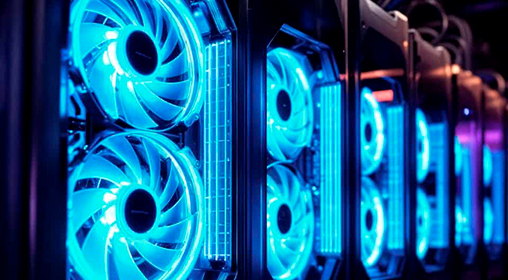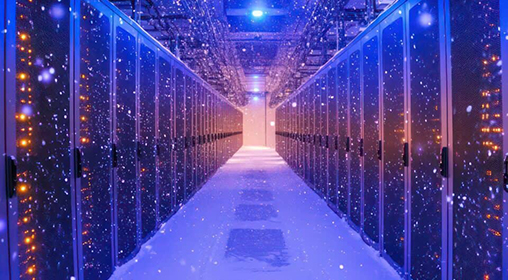



Cooling Considerations for High-Density Data Centers
Compact and powerful — this is the direction technology is heading. Remember the days when mobile phones were bulky and heavy? Over the years, these devices have become smaller, smarter, and more sophisticated, serving as multipurpose pocket-sized computers.
High-density data centers embody this same philosophy, representing a technological breakthrough that maximizes computing power within a compact footprint. And while all data centers must balance power consumption and cooling, high-density facilities are designed to do so more efficiently.
Since cooling is a fundamental requirement for high-density data centers, this blog will explore key cooling considerations suited to such environments’ unique demands and introduce advanced cooling technologies that address these challenges.
5 Cooling Considerations for High-Density Data Centers
What should your dedicated high-density data center cooling system aspire to achieve?
With the increasing demand for data processing power and the compact nature of high-density data centers, cooling systems must be designed to meet specific challenges. Here are five key considerations that a high-density data center cooling system must focus on to ensure optimal performance.
Energy Efficiency
Energy efficiency is among the top priorities in high-density data center cooling. Modern facilities typically operate at power densities of 40 kW to 125 kW per cabinet, with some exceeding these levels. This concentrated computing power generates immense heat, making energy-efficient cooling essential — not just for temperature control but also to counteract high energy usage by IT equipment. Without optimized cooling, high-density data centers face skyrocketing energy costs and excessive Power Usage Effectiveness (PUE) rates.
Advanced cooling units for high-density data centers should feature high-efficiency components, such as variable-speed fans, high-efficiency heat exchangers, intelligent controls, and economization techniques that reduce power consumption. Additionally, artificial intelligence (AI) in cooling systems can optimize airflow, temperature control, and cooling performance in real-time, ensuring that cooling energy is used efficiently without overcooling or unnecessary consumption.
Sustainability
High-density data centers’ rising power consumption and cooling demands not only drive up electricity costs but also raise sustainability concerns. As a result, environmentally friendly cooling solutions are another key requirement for modern high-density data centers.
Two primary strategies enhance cooling sustainability:
- Implementing energy-efficient cooling techniques that optimize energy use.
- Incorporating “green features” into the cooling system to further reduce environmental impact.
For example, deploying cooling systems with built-in sustainable cooling technologies helps reduce carbon footprints while efficiently managing high heat loads. Additionally, using energy-reuse mechanisms, such as heat recovery, can also support sustainability goals. Lastly, selecting green refrigerants with a low global warming potential (GWP) and adopting renewable energy sources allow high-density data centers to further align their cooling infrastructure with environmental initiatives.
Reliability
High-density data centers process significantly more data than traditional facilities, making a cooling system’s reliability a top priority. A cooling failure in these environments can lead to system shutdowns and catastrophic data loss, disrupting businesses relying on real-time computing, AI, and cloud services. To prevent such risks, cooling solutions must be designed for continuous, fail-safe operation. Without reliable cooling, the increased processing power of these data centers becomes a liability rather than an advantage.
Reliability starts with built-in redundancy, such as N+1 or 2N configurations, which provide backup cooling capacity in case of component failure. Advanced monitoring systems, including vibration sensors and predictive analytics, can detect potential issues before they escalate. Additionally, automatic restart functions — as utilized in our UniCool™ cooling system — help maintain stability even after power outages. Beyond hardware redundancy, operational reliability also depends on a well-designed system that simplifies preventative maintenance and ensures efficient servicing. Features like easy-access panels enable quick inspections and repairs, minimizing downtime and keeping the cooling system at peak performance.
Cooling Distribution
Airflow management poses a major challenge in high-density data centers due to space constraints and tightly packed equipment. The proximity of high-performance servers in limited spaces can quickly lead to heat buildup, creating hotspots that strain cooling systems. On top of that, the complex layout of servers and infrastructure restricts natural airflow, increasing the risk of equipment failures and reducing hardware longevity. Given these challenges, effective cooling distribution is essential to maintaining optimal performance and preventing thermal inefficiencies in high-density environments.
To ensure effective cooling distribution, a combination of strategic air management and targeted cooling delivery is required. Close-coupled cooling solutions, such as in-row and rear-door heat exchangers, place cooling systems directly adjacent to heat sources, reducing the distance between heat generation and removal. Additionally, containment strategies, such as hot aisle/cold aisle configurations or full enclosure systems, help direct cool air precisely where needed while preventing hot air recirculation.
Adaptability & Scalability
The rise of AI, cloud computing, and big data processing has been a driving force behind the development of high-density data centers, and these trends are here to stay. As IT demands continue to evolve, data center density will increase accordingly, creating a growing need for adaptable and scalable cooling systems. These systems must efficiently handle varying thermal loads while scaling seamlessly to meet future demands, all without requiring extensive infrastructure modifications.
In such limited space, adding more cooling units to support data center scalability isn’t always an option, avoiding taking up valuable server space. With that in mind, modular cooling units and scalable features, such as variable-speed components, offer a flexible approach by expanding cooling capacity as needed. For example, Our UniCool-Edge™ supports up to six interconnected units with cooling capacities from 7kW to 240kW and rack densities up to 20kW. Our Optima2™ offers modular blocks of up to 16 units, operating individually or as one large system, while LiquidRack™ delivers cooling densities of up to 100kW per rack. Additionally, predictive analytics enhance scalability by forecasting future cooling needs, allowing data centers to optimize resources for long-term efficiency and reliability.
Top 3 Cooling Technologies for High-Density Data Centers
What do targeted cooling solutions for high-density data centers look like?
Targeted cooling technologies for high-density data centers are designed to meet the key considerations discussed above. Here are three leading solutions that excel in these demanding environments:
- Liquid Cooling: Liquid cooling utilizes a network of pipes carrying liquid coolant to absorb and dissipate heat from IT equipment. This method improves cooling capacity while reducing energy consumption, making it ideal for high-density environments with extreme heat loads.
- Immersion Cooling: In immersion cooling, servers are fully submerged in a thermally conductive, dielectric liquid that absorbs and dissipates heat. Immersion cooling dramatically reduces cooling energy consumption and eliminates the need for traditional airflow management.
- Direct-to-Chip Cooling: This targeted approach delivers coolant directly to the hottest components where heat is generated, such as CPUs and GPUs, significantly improving heat dissipation. By eliminating heat at the source, direct-to-chip cooling minimizes reliance on traditional air conditioning, enhancing efficiency in compact, high-density data centers.
Finding the Right Cooling Solution for Your High-Density Data Center
Effective cooling is the backbone of any high-density data center. The right solution should not only effectively manage high heat loads but also support scalability and sustainability. By selecting advanced cooling technologies tailored to your facility’s needs, you can maximize efficiency while preparing for future demands.
High-density data centers are all about balance — maximizing computing power while effectively managing heat and energy consumption. At AIRSYS, we’re on a mission to achieve another critical balance: delivering high-performance cooling solutions that also support environmental sustainability. Our innovative data center cooling solutions are designed to benefit not just data centers and their operators, but also the world around us through efficient and sustainable technologies. Explore our solutions and contact us to learn how we can help you optimize your high-density data center.
Related Posts

Data Center Energy Efficiency: Which Metrics Matter Most?
Cooling systems drive a large share of data center energy use, making them one of the most critical areas to target for improving overall energy efficiency. As demands on data centers increase, cooling will be key to powering the next generation of data centers, further emphasizing the need to measure and manage its impact.
read more
Colocation Cooling Strategies: From Air to Liquid and Everything in Between
Keeping colocation data centers cool isn’t just about temperature; it’s about trust. With multiple tenants relying on shared infrastructure to run critical operations, even minor fluctuations in cooling performance can ripple into major disruptions. As high-density data centers become the norm, the challenge grows, bringing greater heat loads, increased system complexity, and a shrinking margin for error.
read more
Data Centers Scale on Flexible Cooling Strategies
Can you remember going on a road trip 15 years ago? Or how you got around your hometown? Chances are, you used a paper map. At the time, it was the only way to navigate unfamiliar areas. But as cities grew, routes developed, and technologies we couldn’t have imagined back then emerged, paper maps could no longer meet the need. Static maps couldn’t keep up with infrastructure expansion, let alone provide real-time traffic updates or recommend the best routes. And so, gradually, paper maps faded from our lives.
read more